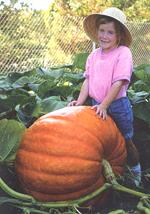| Fruits |
Vegetables
|
Pumpkin, Cucurbita maxima / Cucurbitaceae
|
Note: Composition for 100 g. of fresh product Values in ( min. - max. ) format. | |
| Energy: 13.00-25.76 kcal Fats: 0.2-0.2 g Fibres: 0.78-1.00 g Fat Acids Saturated: 0.1-0.1 gMinerals Calcium: 17-29 mgZinc: 0.2-0.2 mg Chlorine: 37-37 mg Phosporus: 11-43 mg Iron: 0.10-0.77 mg Magnesium: 10-10 mg Manganese: 0.10-0.22 mg Potasium: 130-351 mg Selenium: 1-1 µg Sodium: 7-7 mg | Proteins: 0.3-1.4 kcal Carbohidrates: 2.00-4.59 g Liposoluble Vitamins A Retinol: 0.00-385.08 µgA Carotenoids: 450-2340 µg E or Tocoferol: 1.06-1.06 mg Liposoluble Vitamins B1 or Thiamine: 0.021-0.160 mgB2 or Riboflavine: 0.011-0.060 mg B3 or Niacine: 0.1-0.5 mg B5 or Pantothenic Acid: 0.4-0.4 mg B6 or Piridoxine: 0.02-0.02 mg B9 or Folic Acid: 3-14 mg C or Ascorbic Acid: 3-14 mg |

The pumpkin’s flesh is eaten cooked as a vegetable, fried, au gratin, together with sauces and as garnish for several dishes. However, this flesh is somewhat insipid so it is usually seasoned with aromatic herbs. The winter varieties are widely used in confectionery. Pumpkins are cultivated both for the fruit as for their seeds, which can be consumed as dry fruits or used to obtain fuel oil and cooking oil. The leaves and the flowers are also consumed as vegetables.
Nutrition and eating
The pumpkin fruit contains the following nutritious composition for each 100 g of edible product: 0.38 g of protein, 1.85 g of carbohydrate, 4,000 IU of vitamin A, 60 mcg of vitamin B1, 30 mcg of vitamin B2, 11 mg of vitamin C, 18 mg of calcium, 44 mg of phosphorus, 0.6 mg of iron and 9 calories of energetic value.
The fruit
 The species belonging to the group of pumpkins, within the cucumber family, are the common, courgettes, winter and summer squash and large pumpkins.
The species belonging to the group of pumpkins, within the cucumber family, are the common, courgettes, winter and summer squash and large pumpkins. This denomination includes a series of species and botanical varieties belonging to the genus Cucurbita, whose main application is the consumption of their mature fruit, as much cooked as for making jam, pies, etc.
Some of them, specially some of the cultivars, are used as cattle food. In some Spanish provinces their seeds are directly consumed and in certain Asian countries they obtain an edible oil.
The pumpkin’s flesh is eaten cooked as a vegetable, fried, au gratin, together with sauces and as garnish for several dishes. However, this flesh is somewhat insipid so it is usually seasoned with aromatic herbs. The winter varieties are widely used in confectionery. Pumpkins are cultivated both for the fruit as for their seeds, which can be consumed as dry fruits or used to obtain fuel oil and cooking oil. The leaves and the flowers are also consumed as vegetables.
Pumpkin is a voluminous berry, generally spherical, which has a thick rind, an hexahedric peduncle and pulpy flesh filled with seeds. It is impossible to refer to the colour of its rind since there is a wide range of colours according to the varieties. Red, green, yellow, black, white, orange, grey, blue and a mixture of one and another garnish the rind of this fruit. Moreover, there is no end of shapes: bottle-shaped, rounded, elongate, squashed, tapered, even, rough, oval, square, irregular and unimaginable.
The supply of minerals and vitamin A are quite significant, reaching 5,000-6,000 U.I.
Pumpkins are harvested ripe and they are usually left to sun-dry before their storage. They are normally stored at a temperature of 10-15ºC and relative moisture oscillating between 50-70 %; in these conditions they are kept for more than 6 months.
The plant
The pumpkin is an annual, creeping herbaceous plant, of pentagonal stem, without thorns. The leaves are cordiform pentagonal, with white spots within the nerves. The corolla has large lobes, lanceolate shape and yellow colour. The sepals of the female flowers have lobed leaves. Its pepo fruit, round or ellipsoidal, even or bulky, is covered with a white powder when it is completely ripe. The skin is red, yellowish or orange, with wriggling, reticular, wavy or streaked mottles. The peduncle, pentagonal-shaped, is joined to the fruit, and it is a well-developed part of the base of the stem.
It is native to warm countries and therefore it prefers warm temperatures and it is easily adapted.
Unlike C. pepo (courgettes), there are two species included in the group of winter squashes (C. mostacha and C. maxima) lacking rough hairs on the leaves and are less uneven. The courgette’s peduncle is provided with well-marked ribbings. C. mostacha has a widened and furrowed peduncle, whereas that of C. maxima is cylindrical and even.
The pumpkin C. maxima has round stems, not very rough hairs, whereas those of the C. mostacha are angular and with numerous hard hairs. There are also some differences with respect to the seeds: those of C. maxima do not show a defined edge, whereas those of C. mostacha have a prominent edge.
It is native to warm countries and therefore it prefers warm temperatures and it is easily adapted.
Unlike C. pepo (courgettes), there are two species included in the group of winter squashes (C. mostacha and C. maxima) lacking rough hairs on the leaves and are less uneven. The courgette’s peduncle is provided with well-marked ribbings. C. mostacha has a widened and furrowed peduncle, whereas that of C. maxima is cylindrical and even.
The pumpkin C. maxima has round stems, not very rough hairs, whereas those of the C. mostacha are angular and with numerous hard hairs. There are also some differences with respect to the seeds: those of C. maxima do not show a defined edge, whereas those of C. mostacha have a prominent edge.
| Interempresas Media, S.L. / 2025 | [ Legal notice | Política de Protección de Datos | Política de cookies | Publicidad] |
